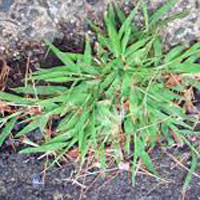Spray nozzle selection contributes to improved postemergence herbicide crabgrass control in turfgrass

Accepted: 25 June 2021
HTML: 30
All claims expressed in this article are solely those of the authors and do not necessarily represent those of their affiliated organizations, or those of the publisher, the editors and the reviewers. Any product that may be evaluated in this article or claim that may be made by its manufacturer is not guaranteed or endorsed by the publisher.
For optimum postemergence crabgrass (Digitaria spp.) control, a single quinclorac herbicide application could be properly timed and delivered with spray nozzles that produce spray droplets ranging from very coarse (401-500 μm) to medium (226-325 μm) in size to maximize target coverage and minimize the potential for drift. Crabgrass is an invasive annual grass weed of cool-season turfgrass maintain as lawns, golf courses, and sports pitches. Postemergence herbicide applications for crabgrass control in turfgrass swards often rely on repeated applications for effective control. Optimizing postemergence crabgrass applications can reduce pesticide inputs and contribute to sustainable turfgrass management practices. Two field studies evaluating crabgrass control were conducted in 2020 in a mixed stand of Kentucky bluegrass (Poa pratensis L.) with perennial ryegrass (Lolium perenne L.) in Ohio (USA) and in perennial ryegrass in Pennsylvania (USA). Both sites have histories of natural crabgrass [Digitaria sanguinalis (L.) Scop.] infestation. A postemergence herbicide, quinclorac, was applied at the product label rate and tank-mixed with methylated seed oil at the crabgrass plant stage of three-leaf to one tiller. Different spray nozzles were selected to deliver the following spray droplet classifications and sizes at 275 kPa: Delavan Raindrop 1/4, ultra coarse (>650 μm); TurfJet 1/4TTJO4, extremely coarse (501-650 μm); Air Induction AA8004 or XRTeeJet 8015, very coarse (401-500 μm); XR TeeJet 8008 or GreenLeaf TDAD04, coarse (326-400 μm); XR TeeJet 8004, medium (226-325 μm); and XRTeeJet 8003 fine (145-225 μm). Crabgrass pressure was low in Ohio, and herbicide efficacy at 60 days after treatment was considered acceptable when applied from all spray nozzles that produced spray droplet sizes ranging from ultra coarse to fine. Crabgrass pressure was severe in Pennsylvania, and herbicide efficacy at 60 DAT was considered marginally acceptable when applied from spray nozzles that produced spray droplet sizes ranging from very coarse to medium. Future research should consider cultural practices that would be complementary to postemergence herbicide applications with the goal to reduce pesticide use further and minimize any potential environmental impacts related to spray drift.
Highlights
- In turfgrass sites with low crabgrass pressure, one postemergence application of quinclorac herbicide could potentially achieve acceptable control with spray nozzles that produce spray droplets ranging from ultra coarse (>650 μm) to fine (145-225 μm).
- In turfgrass sites with heavy crabgrass population and pressure, one postemergence application of quinclorac herbicide is best optimized with spray nozzles that produce spray droplets ranging from very coarse (401-500 μm) to medium (226-325 μm).
- Overall, turfgrass management practitioners should avoid using spray nozzles that produce a hollow cone spray pattern with ultra coarse (>650 μm) spray droplets which can result in poor or irregular herbicide coverage, or fine (145-225 μm) spray droplets which are subject to potential drift and possible negative off-target effects.
- Overall, in an effort to reduce herbicide use for postemergence crabgrass control, a single quinclorac herbicide application could be properly timed and optimized with nozzles that produce spray droplets ranging from very coarse (401-500 μm) to medium (226-325 μm) in size, however, future research should consider cultural practices that would further optimize and also reduce herbicide applications.
How to Cite

This work is licensed under a Creative Commons Attribution-NonCommercial 4.0 International License.
PAGEPress has chosen to apply the Creative Commons Attribution NonCommercial 4.0 International License (CC BY-NC 4.0) to all manuscripts to be published.

 https://doi.org/10.4081/ija.2021.1846
https://doi.org/10.4081/ija.2021.1846



